Imagine stumbling upon a mathematical conundrum that tickles your brain, a puzzle that blends the charm of numbers with the thrill of discovery. This is the world of Yohaku puzzles, where each challenge is a gateway to the exhilarating realm of mathematics. Inspired by a Yohaku puzzle I encountered on Twitter, I embarked on a quest to transform this traditional puzzle into a dynamic and interactive experience using Google Sheets. This transformation wasn’t just about moving from paper to pixels; it was about enriching the puzzle-solving journey, offering an infinite canvas of challenges where no two students embark on the same path.
At the heart of this adventure lies the Yohaku puzzle, a beguiling challenge that asks solvers to fill in cells with 9 consecutive odd numbers to match given totals for rows and columns. It’s an invitation to dance with numbers, leveraging the simple yet elegant formula of 2n+1 from algebra, turning abstract concepts into captivating puzzles.
This unofficial add-on collects NO user data. The permissions it asks for is only allowing YOU to access your own files. This warning is in all unofficial add-ons since clearly they were not submitted to the Google Marketplace.
Yohaku Puzzle – Addition
Fill in cells with 9 consecutive odd numbers to get totals in each row/column.

I’m a math teacher so “9 consecutive odd numbers” made me excited. Finally an excuse to use the 2n+1 from Algebra!!! I might have had too much fun coding this puzzle.
4 C’s Check
Most worksheets have NONE of the 4C’s. Let’s see how many this one has.
DOK 3 Strategic Thinking (Critical Thinking)
Math puzzles like this can be great for having strategic thinking math conversations. It’s also a great hook into a lesson on consecutive integers 🙂 You don’t have to be an Algebra student to enjoy these puzzles! You can find more on the Yohaku website.
Creative Thinking
Not collecting 30 of the same thing. Students will come up with creative (and different) strategies to solve the puzzles.
Collaborate
Students are going to have to talk these problems out. Suggest students work in pairs or groups to strategize a solution together. But regardless, it’s Google Sheets so it has collaboration baked in. Students can share puzzles and insert feedback comments to help each other think out the reasoning.
Clearly Communicate Ideas
If we ask students to share their strategy
Yohaku Menu
Get started by using the Yohaku menu. (Note, I coded this with Google Apps Script so it must be generated from a computer; not mobile. However, once the puzzle is generated it can be shared and used on mobile.) Choose “Create Puzzle” from the menu.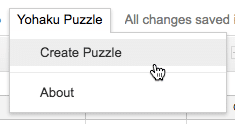
Email Address
You will then be prompted to enter an email address. The answer key is emailed to that address, the spreadsheet is shared with that email address and the person is linked back to the spreadsheet. In other words, the kids should enter the teacher’s email address 🙂 If an invalid (or none) email is entered a pop-up window will list the answer key.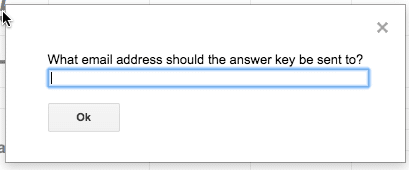
Unlimited Puzzles
You can use the menu multiple times, an additional sheet will be created with an additional puzzle.
Sum
Enter numerical values into the yellow cells such that the rows and columns add up to the summed number on the edges. If the column or row adds up to the summed value on the edge, it will format green.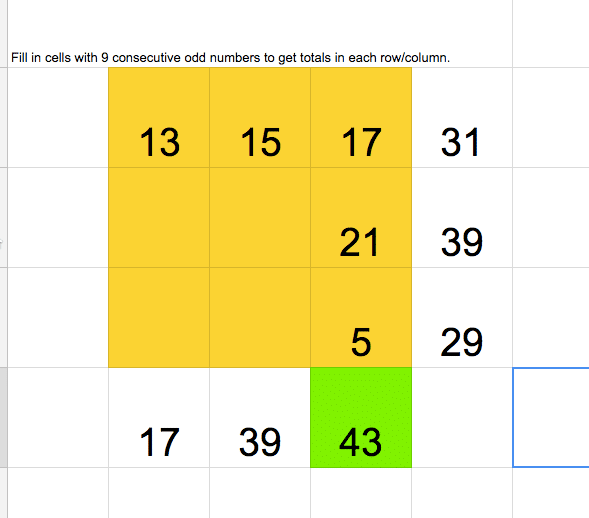
Notice in my example I was able to get the 3rd column to sum to 43, however number sense… can 5 be part of the set of numbers if 13, 15, 17 and 21 are in the data set? Remember to get students to talk about their strategy and defend their reasoning!
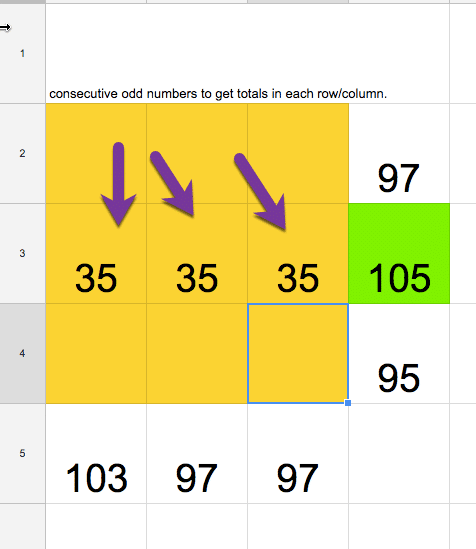
My 11 year old was trying out this puzzle. At first, he typed in 103 in the column that is supposed to add up to 105. So we talked about… what is the range of possible values if you use the number 103? 103, 105, 107, 109, 111, 113, 115, 117, 119 IF 103 was the smallest number. 103, 101, 99, 97, 95, 93, 91, 89, 87 IF 103 was the largest number. Or it is somewhere in between the 9 consecutive odd integers. Could the sum of 3 of these numbers between 87 and 119 add up to 105? No. Any 3 of these numbers would exceed 105.
So he deleted that. He then observed that 35 + 35 + 35 = 105. Great, except then you don’t have consecutive odd integers. And the “consecutive” are within the grid of 9, not necessarily the 3 cells in a row!! My son asked me “Could there be a 33 and a 37 but not a 35?” Well…. you tell me, can there? No, if you have consecutive you need all the ones in between.
So you can see how he and I were having some great number sense conversations as he worked out this puzzle.
Don’t Delete Mistakes
Another advantage to using a spreadsheet is you do not have to lose the mistakes. As Stanford math professor Jo Boaler says, mistakes are part of the learning process. We want to see the student’s strategic thinking. Hard to do that if they delete their attempts. Can’t talk about the students series of strategies if they don’t have a series of strategies.
Duplicate the Tab
When the student makes a mistake, have them DUPLICATE the sheet by clicking on the tiny triangle on the tab and choosing “Duplicate.” Then they can apply a new strategy. Hopefully, the student ends up with a lot a lot of tabs along the bottom as they work through their thinking.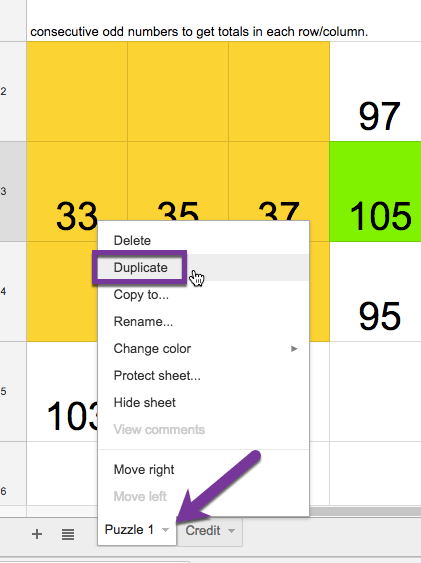

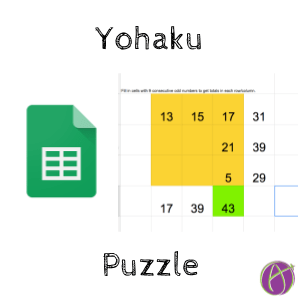








6 thoughts on “Yohaku Puzzle – Of Course Google Sheets”
Why?
Yohaku Puzzle wants to
Read, send, delete, and manage your email
It emails you the answer key.
You’re giving yourself permission by the way. It is YOUR Google Drive using YOUR Gmail.
Do you mind sharing the google apps script code you used to create this? I want to try to hook it up with the Classroom API so that students can directly submit it as an assignment (instead of via email). 😛 (@alexjlockwood)
Go to the script editor on the tools menu.
This looks amazing and I really like the idea of the automatic screen capture. However, sign in with google has been disabled for the SlideShot extension. Any ideas for work arounds or solutions?